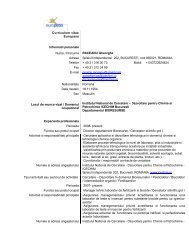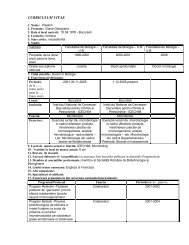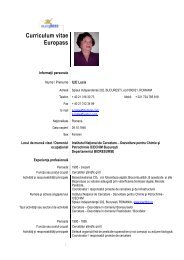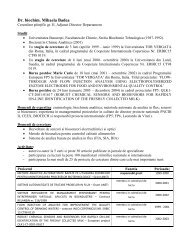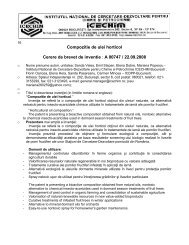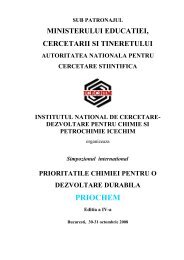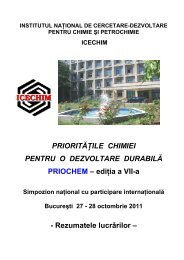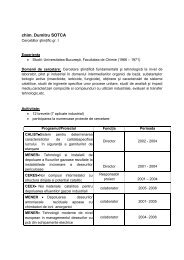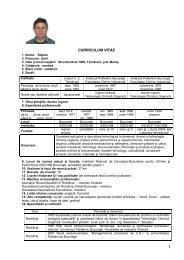INSTITUTUL NAÅ¢IONAL DE CERCETARE-DEZVOLTARE - ICECHIM
INSTITUTUL NAÅ¢IONAL DE CERCETARE-DEZVOLTARE - ICECHIM
INSTITUTUL NAÅ¢IONAL DE CERCETARE-DEZVOLTARE - ICECHIM
- No tags were found...
You also want an ePaper? Increase the reach of your titles
YUMPU automatically turns print PDFs into web optimized ePapers that Google loves.
3. Chemistry in medical and pharmaceutical applications - PLUMINESCENCE STUDIES ON LUMINOL IN DIFFERENT ENVIRONMENTSAlexandru Chivulescu, Emilia Ocnaru, Melania Arsene, Mihaela Badea-DoniNational Research & Development Institute for Chemistry & Petrochemistry - <strong>ICECHIM</strong>,Biotechnology Department, Spl. Independentei 202, Bucharest, ROMANIALuminescence techniques, especially chemiluminescence (CL), have evolved in thelast few years especially due to their sensitivity and simplicity. However, there are still someproblems when applied to real samples, due to their poor selectivity. An interesting alternativemay be the reversed micellar (RM) medium [1, 2]. Reverse micelles are self-organizedaggregates formed by surfactants in organic solvent, and nanometer sized water pools areformed by the solubilization of water in their polar cores. The observations that denaturationof proteins can be prevented in reverse micelles have spurred even more interest in theapplication of these self-organized multi-molecular assemblies as either drug delivery carriersor life-mimicking systems. When performed in RM medium, the selectivity and also thesensitivity of CL reactions can be dramatically improved due to the bioseparation capabilityof the reversed micelles.Studies regarding the fluorescence and chemiluminescence of luminol in differentenvironments have been conducted. These include aqueous media, at several pH values, aswell as RM medium (AOT – iso-octane). Luminol solutions with pH ranging from 7 to 13were tested in regards to the excitation spectra, and two absorption bands were observed forall the above: one in the 260 nm region and another around 380 nm. Emission FL spectrawere also recorded, for each of the two excitation wavelengths, and a correlation wasdeveloped between the fluorescence intensity and the pH value. Furthermore, fluorescenceemission following the luminol reaction with hydrogen peroxide in presence of potassiumferricyanide was studied. The enhancing effect of reverse micelle environment on thefluorescence intensity of luminol was also tested.[1]. K. Tonova, Z. Lazarova, Biotechnology Advances, 26, 2008, p. 516–532;[2]. J.-M. Lin, M. Yamada, Trends in Analytical Chemistry, 22 (2), 2003, p. 99-107.




